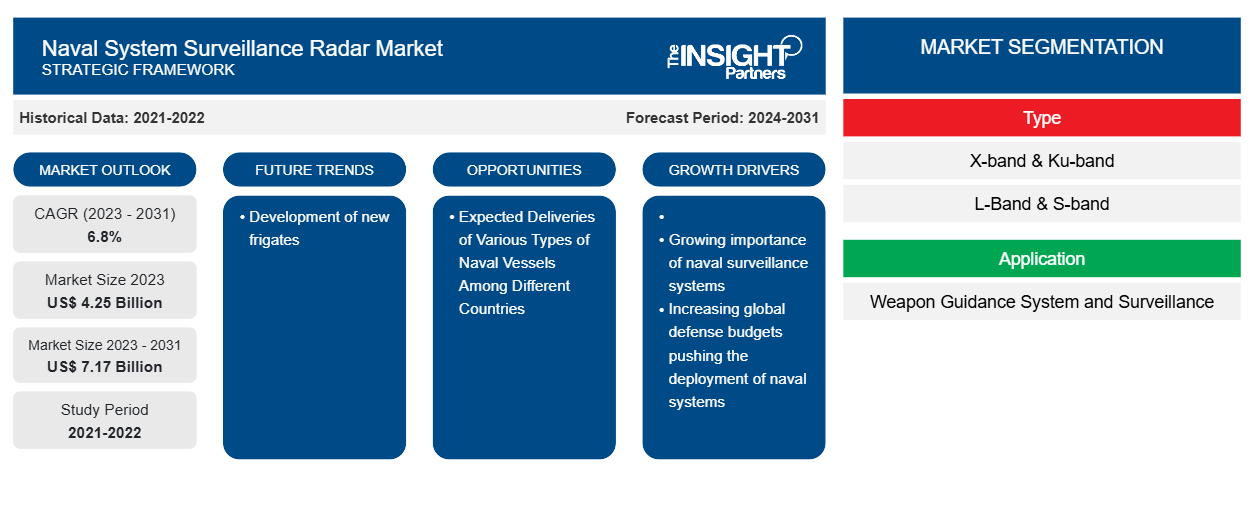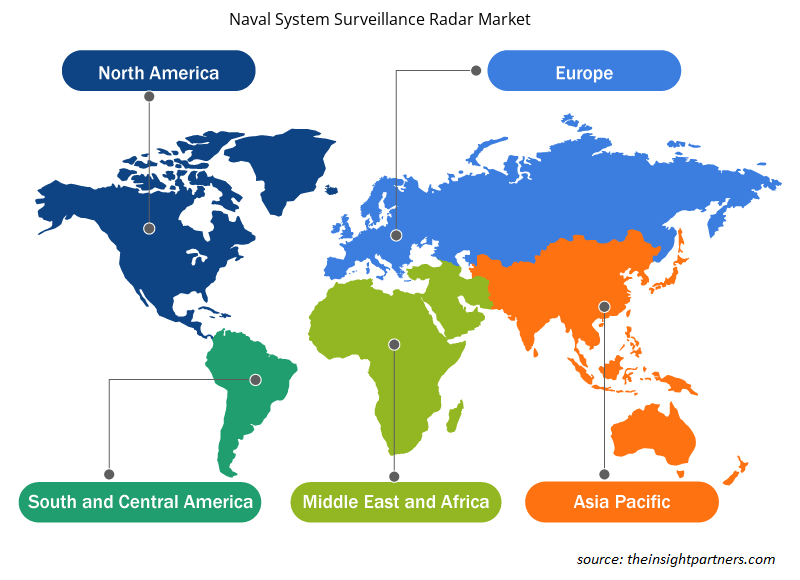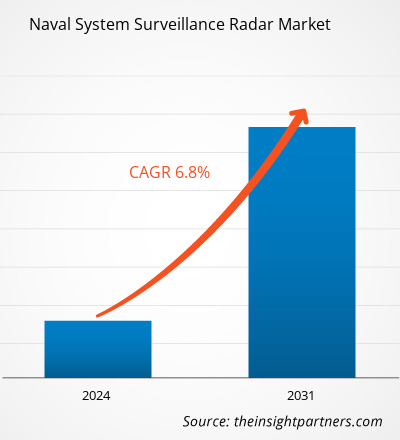The naval system surveillance radar market size is projected to reach US$ 7.17 billion by 2031 from US$ 4.25 billion in 2023. The market is expected to register a CAGR of 6.8% during 2023–2031. Development of new frigates is likely to remain a key trend in the market.
Naval System Surveillance Radar Market Analysis
Naval system surveillance radar is one of the key products of orders, surveillance, navigation, navy intelligence, and many more among the naval forces. There is a low to low threat of substitutes in the naval system surveillance market. Owing to the fact that the naval sectors globally procure only naval system surveillance radar for national security and navigation exercises. Thus, a complete substitute is not available in the market in the current scenario. However, technology upgrades and advancements prevail. Hence, the impact of threats to substitutes on the naval system surveillance radar market is expected to remain low during the coming years.
Naval System Surveillance Radar Market Overview
The major stakeholders in the global naval system surveillance radar market ecosystem include component manufacturers, naval system surveillance radar manufacturers, and end-users amongst others. A naval radar system is made up of various components which are procured by the system manufacturers from a huge base of component manufacturers. These component manufacturers supply the base parts to the global naval system surveillance radar players. The manufacturers are the companies that are engaged in manufacturing the final surveillance radar systems after integrating each component. Some of the major players operating in the market include Lockheed Martin Corporation, Northrop Grumman Corporation, Raytheon Technologies Corporation, Saab AB, and Thales Group amongst others. The end-user of the global naval system surveillance radar market includes all naval forces across the globe. the naval forces integrate the radar with submarines, boats, ships, and naval vessels amongst others for applications such as surveillance and weapon guidance systems.
Customize This Report To Suit Your Requirement
You will get customization on any report - free of charge - including parts of this report, or country-level analysis, Excel Data pack, as well as avail great offers and discounts for start-ups & universities
Naval System Surveillance Radar Market: Strategic Insights

- Get Top Key Market Trends of this report.This FREE sample will include data analysis, ranging from market trends to estimates and forecasts.
You will get customization on any report - free of charge - including parts of this report, or country-level analysis, Excel Data pack, as well as avail great offers and discounts for start-ups & universities
Naval System Surveillance Radar Market: Strategic Insights

- Get Top Key Market Trends of this report.This FREE sample will include data analysis, ranging from market trends to estimates and forecasts.
Naval System Surveillance Radar Market Drivers and Opportunities
Increasing Global Defense Budgets Pushing the Deployment of Naval Systems
The rise in global military expenditure is one of the major factors pushing the procurement and deployment of naval systems including radars across different regions. For instance, according to the data published by the Stockholm International Peace Research Institute (SIPRI), between 2019 and 2022, global military spending experienced a rise of around 8.4% which shows a string growth in investments in military technologies. Such factors have been pushing the deployment of naval systems and thereby driving the growth of the naval system surveillance radar market.
Expected Deliveries of Various Types of Naval Vessels Among Different Countries
The expected future deliveries of different types of naval vessels such as frigates, corvettes, carriers, submarines, and destroyers is likely to boost the demand for naval system surveillance radars across different regions in the coming years. For instance, in 2023, the US had a fleet of around 243 naval vessels. Also, as per The Insight Partner’s secondary research, more than 65 naval vessels (including 15 frigates, 21 destroyers, 19 submarines, 9 aircraft carriers, and 3 patrol vessels) worth of orders have been already placed from the US naval forces. This will further generate the demand for new installations of naval system surveillance radars in the US. Such factors are likely to generate new opportunities for market vendors in the coming years.
Naval System Surveillance Radar Market Report Segmentation Analysis
Key segments that contributed to the derivation of the naval system surveillance radar market analysis are type and application.
- Based on type, the naval system surveillance radar market is segmented into X-band & Ku-band, L-band & S-band, and others. The X-band & Ku-band segment held a larger market share in 2023.
- Based on application, the naval system surveillance radar market is segmented into weapon guidance system and surveillance. The surveillance segment held a larger market share in 2023.
Naval System Surveillance Radar Market Share Analysis by Geography
The geographic scope of the naval system surveillance radar market report is mainly divided into five regions: North America, Europe, Asia Pacific, Middle East & Africa, and South America.
North America has dominated the market in 2023 followed by Europe and Asia Pacific regions. Further, Asia Pacific is also likely to witness highest CAGR in the coming years. The US dominated the North America naval system surveillance radar market in 2023. The US accounts for the largest share in the naval system surveillance radar market in North America due to the early adoption of radar technology. Additionally, the US has the largest defense budget in the world and a large amount of budget is contributed towards the adoption and procurement of upgraded weapons systems. According to research by the United States Department of Transportation's Maritime Administration (MARAD), the shipbuilding industry contributes significantly to the country's GDP. The entire budget request for the Department of Navy for FY 2023 is US$ 230.8 billion, with the Navy receiving US$ 180.5 billion and the Marine Corps receiving US$ 50.3 billion. The Navy is requesting US$ 53.35 billion in procurement funding, a 5.4% increase over FY 2023. This contributes to the demand for naval system surveillance radar across the country. The United States ranks 3rd in the world and the country has 484 navy fleets according to a Global Firepower. The rising fleet across the US Navy also acts as a supporting factor for the naval system surveillance radar market growth in the country.
Naval System Surveillance Radar Market Regional Insights
The regional trends and factors influencing the Naval System Surveillance Radar Market throughout the forecast period have been thoroughly explained by the analysts at Insight Partners. This section also discusses Naval System Surveillance Radar Market segments and geography across North America, Europe, Asia Pacific, Middle East and Africa, and South and Central America.

- Get the Regional Specific Data for Naval System Surveillance Radar Market
Naval System Surveillance Radar Market Report Scope
| Report Attribute | Details |
|---|---|
| Market size in 2023 | US$ 4.25 Billion |
| Market Size by 2031 | US$ 7.17 Billion |
| Global CAGR (2023 - 2031) | 6.8% |
| Historical Data | 2021-2022 |
| Forecast period | 2024-2031 |
| Segments Covered |
By Type
|
| Regions and Countries Covered | North America
|
| Market leaders and key company profiles |
Naval System Surveillance Radar Market Players Density: Understanding Its Impact on Business Dynamics
The Naval System Surveillance Radar Market is growing rapidly, driven by increasing end-user demand due to factors such as evolving consumer preferences, technological advancements, and greater awareness of the product's benefits. As demand rises, businesses are expanding their offerings, innovating to meet consumer needs, and capitalizing on emerging trends, which further fuels market growth.
Market players density refers to the distribution of firms or companies operating within a particular market or industry. It indicates how many competitors (market players) are present in a given market space relative to its size or total market value.
Major Companies operating in the Naval System Surveillance Radar Market are:
- Lockheed Martin Corporation
- Northrop Grumman Corporation
- Raytheon Technologies Corporation
- Saab AB
- Thales Group
- BAE Systems
Disclaimer: The companies listed above are not ranked in any particular order.

- Get the Naval System Surveillance Radar Market top key players overview
Naval System Surveillance Radar Market News and Recent Developments
The naval system surveillance radar market is evaluated by gathering qualitative and quantitative data post primary and secondary research, which includes important corporate publications, association data, and databases. A few of the developments in the naval system surveillance radar market are listed below:
- Northrop Grumman Corporation has secured a contract worth US$ 167 million for the modification of the US Navy’s G/ATOR radar technology. (Source: Northrop Grumman Corporation, Press Release, Apr 2024)
- The U.S. Navy is putting the advanced AN/SPY-6 naval radar on 29 new ships, and now it will add this system to the first existing ships, starting with a $619 million contract with Raytheon, an RTX business. (Source: Raytheon Technologies Corporation, Press Release, Apr 2023)
Naval System Surveillance Radar Market Report Coverage and Deliverables
The “Naval System Surveillance Radar Market Size and Forecast (2021–2031)” report provides a detailed analysis of the market covering below areas:
- Naval system surveillance radar market size and forecast at global, regional, and country levels for all the key market segments covered under the scope
- Naval system surveillance radar market trends as well as market dynamics such as drivers, restraints, and key opportunities
- Detailed porter’s five forces analysis
- Naval system surveillance radar market analysis covering key market trends, global and regional framework, major players, regulations, and recent market developments
- Industry landscape and competition analysis covering market concentration, heat map analysis, prominent players, and recent developments for the naval system surveillance radar market
- Detailed company profiles
Frequently Asked Questions
Which region dominated the naval system surveillance radar market in 2023?
North America region dominated the naval system surveillance radar market in 2023.
What are the driving factors impacting the naval system surveillance radar market?
Growing importance of naval surveillance systems and increasing global defense budgets pushing the deployment of naval systems are some of the factors driving the growth for naval system surveillance radar market.
What are the future trends of the naval system surveillance radar market?
Development of new frigates is one of the major trends of the market.
Which are the leading players operating in the naval system surveillance radar market?
Lockheed Martin Corporation, Northrop Grumman Corporation, Raytheon Technologies Corporation, Saab AB, Thales Group, BAE Systems Plc, Israel Aerospace Industries Ltd, Leonardo SpA, Ultra, and HENSOLDT AG are some of the key players profiled under the report.
What would be the estimated value of the naval system surveillance radar market by 2031?
The estimated value of the naval system surveillance radar market by 2031 would be around US$ 7.17 billion.
What is the expected CAGR of the naval system surveillance radar market?
The naval system surveillance radar market is likely to register of 6.8% during 2023-2031.
- Historical Analysis (2 Years), Base Year, Forecast (7 Years) with CAGR
- PEST and SWOT Analysis
- Market Size Value / Volume - Global, Regional, Country
- Industry and Competitive Landscape
- Excel Dataset
- Aircraft MRO Market
- Helicopter Hoists Winches and Hooks Market
- Fixed-Base Operator Market
- Aerospace Fasteners Market
- Aerospace Stainless Steel And Superalloy Fasteners Market
- Aircraft Floor Panel Market
- Military Optronics Surveillance and Sighting Systems Market
- Smoke Grenade Market
- Airport Runway FOD Detection Systems Market
- Artillery Systems Market
Testimonials
I wish to appreciate your support and the professionalism you displayed in the course of attending to my request for information regarding to infectious disease IVD market in Nigeria. I appreciate your patience, your guidance, and the fact that you were willing to offer a discount, which eventually made it possible for us to close a deal. I look forward to engaging The Insight Partners in the future, all thanks to the impression you have created in me as a result of this first encounter.
DR CHIJIOKE ONYIA, MANAGING DIRECTOR, PineCrest Healthcare Ltd.The Insight Partners delivered insightful, well-structured market research with strong domain expertise. Their team was professional and responsive throughout. The user-friendly website made accessing industry reports seamless. We highly recommend them for reliable, high-quality research services
Yukihiko Adachi CEO, Deep Blue, LLC.Reason to Buy
- Informed Decision-Making
- Understanding Market Dynamics
- Competitive Analysis
- Customer Insights
- Market Forecasts
- Risk Mitigation
- Strategic Planning
- Investment Justification
- Identifying Emerging Markets
- Enhancing Marketing Strategies
- Boosting Operational Efficiency
- Tracking Industry Innovations
- Aligning with Regulatory Trends
Yes! We provide a free sample of the report, which includes Report Scope (Table of Contents), report structure, and selected insights to help you assess the value of the full report. Please click on the "Download Sample" button or contact us to receive your copy.
Absolutely — analyst assistance is part of the package. You can connect with our analyst post-purchase to clarify report insights, methodology or discuss how the findings apply to your business needs.
Once your order is successfully placed, you will receive a confirmation email along with your invoice.
• For published reports: You’ll receive access to the report within 4–6 working hours via a secured email sent to your email.
• For upcoming reports: Your order will be recorded as a pre-booking. Our team will share the estimated release date and keep you informed of any updates. As soon as the report is published, it will be delivered to your registered email.
We offer customization options to align the report with your specific objectives. Whether you need deeper insights into a particular region, industry segment, competitor analysis, or data cut, our research team can tailor the report accordingly. Please share your requirements with us, and we’ll be happy to provide a customized proposal or scope.
The report is available in either PDF format or as an Excel dataset, depending on the license you choose.
The PDF version provides the full analysis and visuals in a ready-to-read format. The Excel dataset includes all underlying data tables for easy manipulation and further analysis.
Please review the license options at checkout or contact us to confirm which formats are included with your purchase.
Our payment process is fully secure and PCI-DSS compliant.
We use trusted and encrypted payment gateways to ensure that all transactions are protected with industry-standard SSL encryption. Your payment details are never stored on our servers and are handled securely by certified third-party processors.
You can make your purchase with confidence, knowing your personal and financial information is safe with us.
Yes, we do offer special pricing for bulk purchases.
If you're interested in purchasing multiple reports, we’re happy to provide a customized bundle offer or volume-based discount tailored to your needs. Please contact our sales team with the list of reports you’re considering, and we’ll share a personalized quote.
Yes, absolutely.
Our team is available to help you make an informed decision. Whether you have questions about the report’s scope, methodology, customization options, or which license suits you best, we’re here to assist. Please reach out to us at sales@theinsightpartners.com, and one of our representatives will get in touch promptly.
Yes, a billing invoice will be automatically generated and sent to your registered email upon successful completion of your purchase.
If you need the invoice in a specific format or require additional details (such as company name, GST, or VAT information), feel free to contact us, and we’ll be happy to assist.
Yes, certainly.
If you encounter any difficulties accessing or receiving your report, our support team is ready to assist you. Simply reach out to us via email or live chat with your order information, and we’ll ensure the issue is resolved quickly so you can access your report without interruption.





















 Get Free Sample For
Get Free Sample For